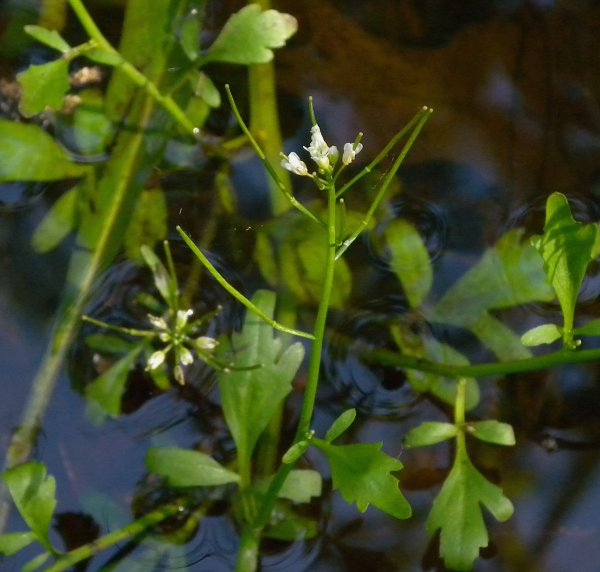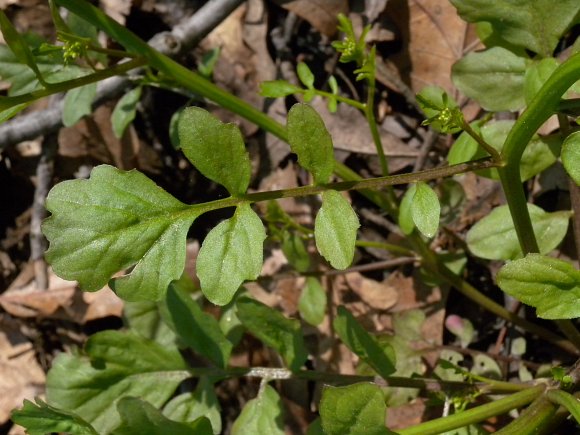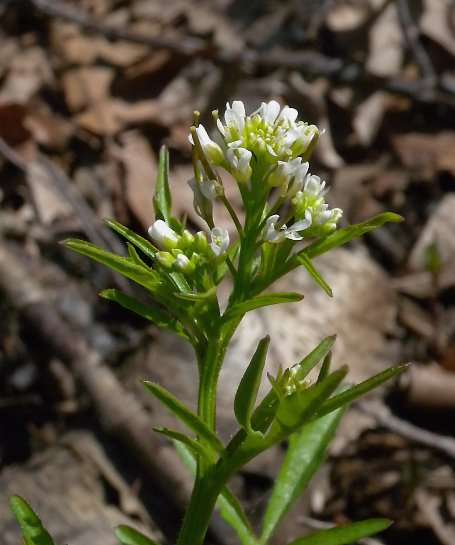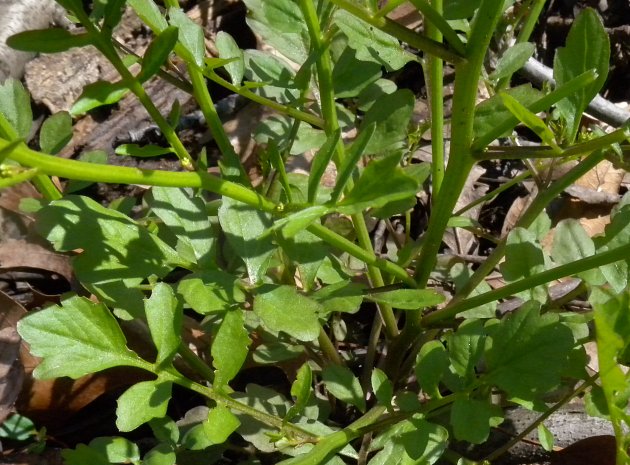Description: This plant is a winter annual or biennial up to 2½' tall that branches occasionally. A few basal leaves are produced during the fall, while alternate cauline leaves develop along the stems during the following spring. The stems are green, glabrous, and terete. The leaves are up to 4" long and ¾" across; they are pinnately compound with 3-15 leaflets. The leaflets are linear, oblanceolate, obovate, or orbicular in shape, becoming more narrow on the upper leaves; their margins are usually undulate, shallowly lobed, or dentate with a few blunt teeth. On each leaf, the terminal leaflet is as wide or wider than the remaining leaflets. Both the lower and upper sides of the leaves are green and glabrous. The upper stems terminate in racemes of small white flowers.

Each flower is about 3 mm. (1/8") long, consisting of 4 white petals, 4 light green sepals, a stout pistil, and several stamens. The mature pedicels (5-9 mm. in length) ultimately become longer than the flowers. Both the pedicels and the central stalk (rachis) of the raceme are green and glabrous. The blooming period occurs from mid-spring to early summer and lasts about 1-2 months. Each flower is replaced by a narrowly cylindrical seedpod (or silique) that is up to 1¼" long. The siliques are relatively straight and they spread outward slightly from the central stalk of each raceme. The tips of young siliques often surround the flowers and partially obscure them. Each silique contains a row of tiny seeds; these seeds are about 1 mm. in length, oblongoid-ovoid in shape, and brown. The root system consists of a tuft of shallow fibrous roots. This plant spreads by reseeding itself.

Cultivation:
The preference is light shade to partial sun, wet to moist conditions,
and soil containing loam or sandy loam with decaying organic
matter. This plant develops quickly during the spring when the weather
is cool and moist.
Range & Habitat:
The native Pennsylvania Bitter Cress occurs occasionally in most areas
of Illinois; it tends to be less common or absent in the NW corner of
the state (see Distribution
Map).
Habitats include wet to mesic deciduous woodlands (especially
floodplain and bottomland woodlands), swamps, shady seeps and springs,
the bottom of cliffs, low ground near streams, and areas along woodland
paths. Pennsylvania Bitter Cress is occasionally found in slow-moving
water of seasonal ditches and shallow streams, where it resembles an
emergent-aquatic plant. This plant is found in both higher quality
habitats and
disturbed areas where there is partial to light shade and the
ground is more or less moist. It is sometimes found in sandy areas
where decaying organic material is abundant.

Faunal
Associations:
Occasionally, small bees or flower flies (Syrphidae) visit the flowers,
otherwise
they attract few visitors. Caterpillars of the moth Evergestis
pallidata (Purple-Backed Cabbage Worm) are known to feed on
the foliage of Cardamine spp. (Bitter Cresses),
while caterpillars of the butterfly Anthocharis midea
(Falcate Orangetip) feed on the flowers, buds, and developing seedpods
of these plants. Two aphids, Myzus
cerasi (Black Cherry Aphid) and Rhopalosiphonius staphyleae
(Mangold Aphid), use these plants as summer hosts. Information about
floral-faunal relations for vertebrate animals is currently unavailable.
Photographic Location:
Near or in a stream of a sandy woodland at the Indiana Dunes State Park
in NW Indiana.

Comments: This spring wildflower of woodlands is not very showy and it is often overlooked. This plant has a similar appearance to other Bitter Cresses (Cardamine spp.) with small white flowers, including Cardamine hirsuta (Hairy Bitter Cress) and Cardamine parviflora arenicola (Small-Flowered Bitter Cress). Hairy Bitter Cress, an introduced species, is hairy toward the base and it has abundant basal leaves while the flowers are blooming. Pennsylvania Bitter Cress has very few, if any, basal leaves while the flowers are blooming, and its foliage is completely hairless (at least in Illinois). Small-Flowered Bitter Cress is usually a little smaller in size than Pennsylvania Bitter Cress and it has more narrow leaflets (up to ¼" across). The terminal leaflets of this species are about the same size as the non-terminal leaflets. Small-Flowered Bitter Cress is usually found in habitats that are drier and sunnier than Pennsylvania Bitter Cress, although it is occasionally found in moist woodlands and wetlands as well.